Observing and sampling aerosol particles in the oceanic atmosphere
in order to investigate their impact on the global environment
It has been a long time since the media began to frequently use the word “aerosol.” As you are aware, this word has been used in referring how COVID-19 is transmitted and thus became widely known to the public. However, since it is not a medical term, even among doctors and many people, the details of aerosols are largely unknown. Associate Professor Yoko Iwamoto is an expert who has continued to study aerosols for many years.
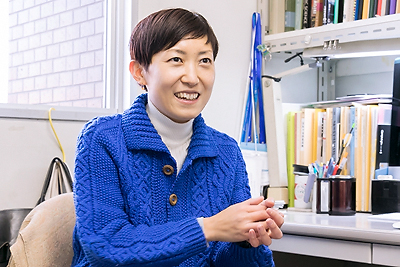
Now, let us explain about aerosols once again. They are fine particles suspended in the air. They are also called “dust particles,” “soot particles” and various other names, according to the process by which they are formed.
Associate Professor Iwamoto says, “In actuality, aerosols are closely connected to our everyday lives than previously thought and come in various types. For example, PM2.5 refers to aerosol particles with a diameter of less than 2.5 micrometers. Other types of aerosols include cigarette smoke, pollen and viruses.”
Scientists have understood that aerosol particles have impacts such as causing air pollution, as well as human health problems including asthma, bronchitis and other respiratory disorders. For this reason, these particles have long been the objects of much discussion. Recent studies have pointed out that aerosol particles are also associated with global environmental problems, such as global warming and ozone depletion, giving rise to an urgent need to identify what roles they play in this regard.
Associate Professor Iwamoto is particularly intrigued by the oceanic atmosphere, i.e., aerosol particles in the atmosphere above the oceans. So, she is investigating the impact of these aerosol masses on climate and biogeochemical cycles.
Why is she so interested in the oceanic atmosphere?
She explains, “There is a close relationship between the oceans and the atmosphere.” She continues, “Oceans cover approximately 70% of the Earth’s surface. For instance, phytoplankton living in the sea surface absorb carbon dioxide from the atmosphere. If we are to look at global environmental problems, we have to look into the interaction between the ocean and the atmosphere. It is also important to understand the roles that aerosols play in the oceanic atmosphere when considering global environmental problems.”
Among other things, she places her primary focus on the impact on marine ecosystems when aerosol particles containing nitrogen, phosphorus, iron and other essential elements affecting living organisms are deposited into the ocean.
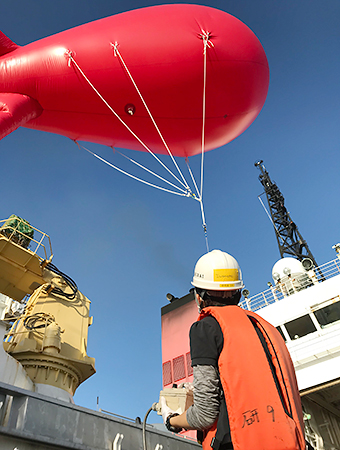 Balloon-borne observation on a research vessel
Balloon-borne observation on a research vessel
Exploring the impact of aerosols
which can also help prevent global warming by using numerical models, etc
Associate Professor Iwamoto has been active conducting fieldwork in oceans around Japan and abroad to address the scarcity of observation data. She makes effective use of a large research vessel for investigation on the oceans. According to her account, she has been to the Arctic Ocean, the Indian Ocean and other seas, where she has spent a month or more conducting research, while living onboard the vessel together with 30 to 40 other researchers.
She explains, “On the vessel, we carry out atmospheric observations, during which aerosols are collected by filtering the air samples. The observation team comprises researchers working on various subjects, such as seawater constituents and plankton, but those who pursue atmospheric research are in the minority. All the team members work together to implement observations using sophisticated equipment. Through exchanges with members from different disciplines, we can also obtain new information.”
The opportunity to make observations on the oceans is extremely precious, and the data acquired from this fieldwork is truly valuable. However, what can be surveyed on the vessel is confined to something observable along the cruise track. To offset this drawback, she is working in collaboration with experts in numerical modeling, as well as remote sensing researchers who use observation satellites. These advanced technologies can fully demonstrate their advantages, especially in making estimations of the wide-ranging impact of aerosols, for example, the amount of particulate matter transported from the atmosphere to the ocean.
 Training and research vessel Toyoshio Maru viewed from a workboat
Training and research vessel Toyoshio Maru viewed from a workboat
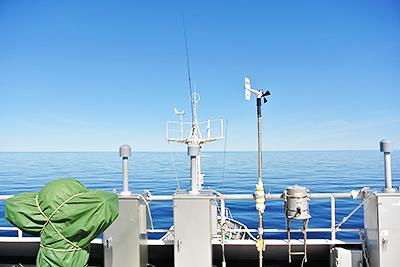 Atmospheric monitoring equipment installed on the uppermost deck
Atmospheric monitoring equipment installed on the uppermost deck
Samplers for collecting aerosols have also been installed on the rooftop of Building A of the School of Integrated Arts and Sciences, Hiroshima University.
She says, “These samplers are designed to survey how much aerosol particles there are in the atmosphere that are capable of forming clouds. Aerosols are indispensable for cloud formation since they act as nuclei of cloud droplets. Since clouds are white, they reflect incoming sunlight thereby cooling the Earth. If the cloud droplets grow, rain occurs. In this manner, aerosols have an impact on the hydrological cycle as well.”
Although only the negative impacts of aerosols tend to be talked about, their positive impacts are also being clarified, as in the case of their beneficial effect on climate.
“As has been discussed above, since atmospheric aerosols have the properties of scattering and absorbing sunlight, they reduce the amount of sunlight reaching the Earth. Moreover, aerosol particles falling into the ocean also support the growth of phytoplankton, which perform photosynthesis by consuming carbon dioxide from the atmosphere,” says Dr. Iwamoto.
Phytoplankton growth requires nitrogen, phosphorus, iron and other nutrients. However, while there are limited amounts of nutrients in the ocean, some atmospheric aerosols contain an abundance of these nutrients. Aerosol particles falling into the ocean can facilitate the growth of phytoplankton, which in turn absorbs carbon dioxide through photosynthesis. Associate Professor Iwamoto is also working on quantitative analysis of such biogeochemical cycles.
She says with a smile, “One of the interesting aspects of my research is that I can visit places where you cannot normally go.” In addition to open-sea sampling, she has been conducting observations in forests and tips of peninsulas in Japan, at the weather station atop Mt. Fuji, on the roof of Tokyo Skytree, and so forth. She is planning to continue her open-sea observation activities in the future, while establishing a monitoring system for observing the nearby Seto Inland Sea within a research project unique to Hiroshima University. The Toyoshio Maru, a training and research vessel belonging to the School of Applied Biological Science, Hiroshima University, provides dependable support for these activities.
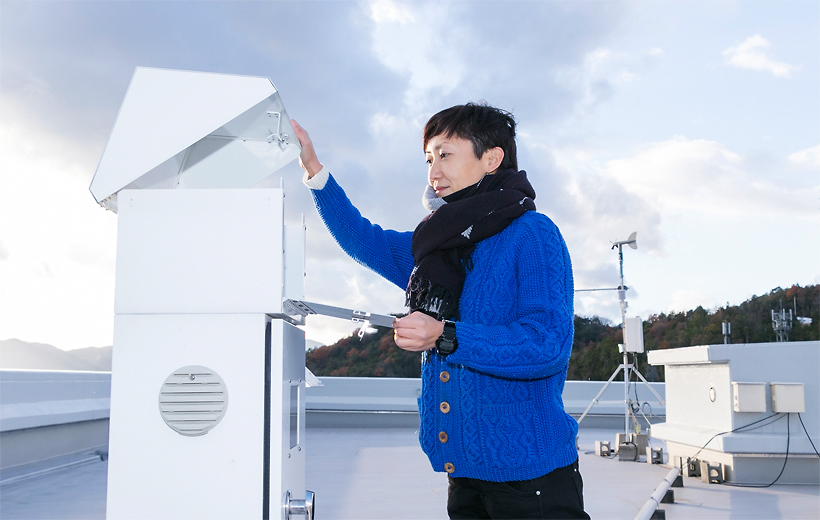
Pursuing research into the impact on nutrient cycling in the Seto Inland Sea area,
aiming to contribute to the UN Decade of Ocean Science
She says, “For the last 30 years or so, the Seto Inland Sea has seen a drastic decrease in the inflow of nutrients from rivers, resulting in a lower nutrient concentration. It is said that the production capacity of phytoplankton at the base of the food chain has been reduced. This reduction may be a factor in declining fish catches. I would like to introduce the perspective of the atmosphere, which has not been conventionally conceived of, into our research on nutrient cycling in the Seto Inland Sea.”
 Associate Professor Iwamoto at work on the vessel
Associate Professor Iwamoto at work on the vessel
Another goal she has set for the near future is to implement activities aimed at contributing to “The United Nations Decade of Ocean Science (UN Ocean Decade)”※, which started in 2021. “It is expected that this UN Ocean Decade will attract public attention on the importance of “sustainable oceans” in society as a whole. In response to this expectation, I will continue working to achieve research results that will enable us to give back to society,” says Associate Professor Iwamoto.
- ※The United Nations Decade of Ocean Science: The United Nations General Assembly in December 2017 resolved that 2021 to 2030 would be the "United Nations Decade of Ocean Science for Sustainable Development. During this Decade, initiatives will be pursued with an intensive focus on promoting ocean science, toward the realization of Sustainable Development Goal 14 (SDG 14), which is about “Life Below Water.”
Regarding the real pleasure of research, she says, “This research involves the task of discovering universal phenomena from snapshot observation data. When we obtain results different from what we imagined, we should consider the reason for the difference. I find this thinking process interesting. Although you may have some difficulty getting used to it at first, you will feel pleasure as those reasons gradually become clearer to you.” She wants many more people to know about the great significance of her research subject—aerosols—despite their tiny size.
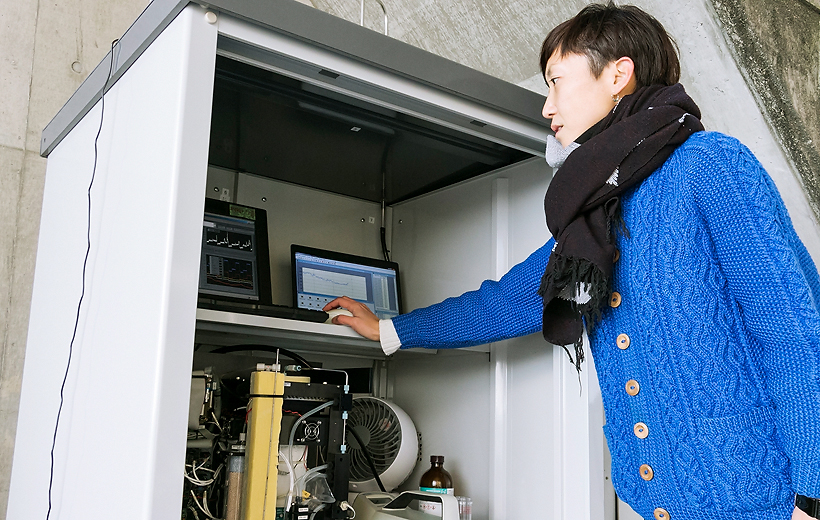 Opened on June 8, 2022
Opened on June 8, 2022


